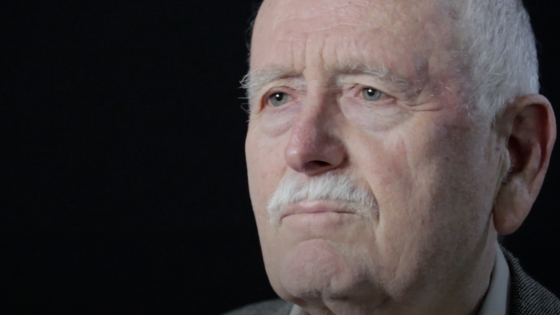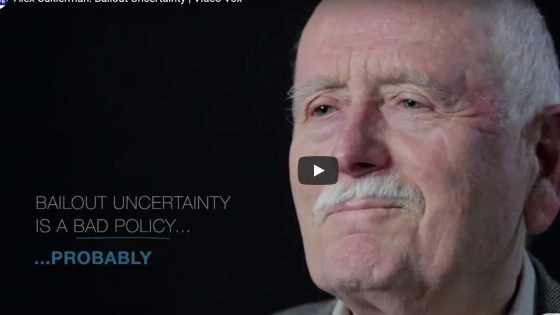The independence of central banks is a backbone of modern economic policy analysis. If the interaction between the actions of central bankers and the rules that govern their operations has become an indispensable element of economic debate over the last 50 years, much of the credit must go to the work of Alex Cukierman, who sadly passed away in October 2023.
Cukierman’s work takes on significant importance when placed in the context of the narrative about the central role of central bank independence in explaining monetary policy performance. This narrative unfolds in three successive steps.
The first step started in the 1980s. Until that moment, macroeconomic theory did not assign much importance to the concepts of central bankers’ preferences and central bank design. Central bank governance gained significance as economic analyses began emphasising its role in shaping macroeconomic outcomes during the ‘new classical revolution’. This role was further affirmed through New Keynesian examinations of monetary policy, typically grounded in the dynamic stochastic general equilibrium (DSGE) framework (Woodford 2003).
The relationship between the policymaker, who designs the overall economic policy, and the central bank, which is usually the technocratic agent responsible for implementing monetary policy, becomes pivotal in mitigating monetary policy bias. The established rules governing this relationship, often referred to as central bank independence, and the inclinations of the individuals involved, known as central banker conservativeness, gain momentum (Sargent and Wallace 1981, Barro and Gordon 1983, Backus and Driffill 1985, Rogoff 1985).
Alex Cukierman has been a presence in this literature since its early stages (Cukierman and Meltzer 1986), highlighting how uncertainty about the central banker’s type can influence the outcomes in terms of the conduct and performance of monetary policy.
The game-theoretical approach that characterised the new approach in analysing monetary policy was adopted to address the shortcomings of traditional monetary policy models (Lucas 1976). Subsequently, a principal-agent approach (Walsh 1995, Chortareas and Miller 2003) further motivated the delegation of monetary policy to non-elected central bankers.
Following the theoretical foundation, the second step brings us to the 1990s, when the challenge shifted to converting the qualitative concept of independence into quantitative indicators. This conversion was necessary to facilitate the implementation of empirical analysis. Researchers began developing sets of indices aimed at capturing the institutional characteristics of central banks (Bade and Parkin 1982, Grilli et al. 1991).
Within this framework, the results that are most frequently cited were produced by Alex Cukierman (Cukierman 1992b, 1994). The key insight was that formal independence, as outlined in laws and regulations, may diverge from actual independence. Even when the rules remain consistent, the actions of politicians can exert a notable influence on the decisions made by central bankers. His 1992 book on central bank strategy, credibility, and independence became a milestone for any scholar interested in uncovering how the central bank setting and the central banker preferences can determine, in theory and practice, the conduct and performances of monetary policy action (Cukierman 1992a).
Now, we move on to the third step. Cukierman’s foundational work, coupled with the enhancement of independence indicators (Romelli 2022), has not only served as an inspiration, but has also catalysed the development of at least three distinct theoretical and empirical advancements since then (Masciandaro 2022).
First, research has investigated the relationship between central bank independence and macroeconomic performance, and the prevailing consensus suggests that as independence increases, there is a corresponding improvement in monetary stability. Importantly, this does not have adverse effects on economic growth, the public finances or financial stability (Alesina and Summer 1993, Jacome and Pienknagura 2022, Buckle 2023).
Second, the literature has taken a significant step to considering central bank governance as an endogenous variable that requires examination. The motivation behind this shift is as follows: during normal times, policymakers grant independence to a conservative central banker. But in extraordinary situations, such as times of crisis, politicians retain the option to override the central banker’s decisions (Lohman 1992). As a result, politicians influence central bank governance, leading to dynamic institutional cycles characterised by fluctuations (Masciandaro and Romelli 2015).
This shift in perspective has opened the door to exploring the factors that drive decisions made by one or more political constituencies either to maintain or reform their monetary regimes (Acemoglou et al. 2008).
Third, the roles of central bankers’ preferences and central bank design became increasingly intertwined and, eventually, the two were merged. The contemporaneous and explicit roles of both elements have been recognised in the literature on monetary policy committees (Blinder and Morgan 2005, Gerlach-Kristen 2006, Dal Bo 2006, Riboni and Ruge-Murcia 2010, Eijffinger et al. 2018, Bordo et al. 2018, Rieder 2022). The incentives of central bankers with heterogeneous preferences are analysed by considering the central bank’s governing bodies, i.e. its committees.
From this perspective, the political economy methodology has been enhanced by incorporating insights from behavioural economics, which consider the influence of psychological variables (Favaretto and Masciandaro 2016).
Lastly, the findings of literature addressing the relationship between central bank governance and monetary policy have been instrumental in interpreting contemporary policy events, particularly given the increased economic and political significance of central banks in advanced economies following the onset of the Global Financial Crisis of 2007-09.
The lines separating the central bank’s role as a liquidity manager and the government’s support for banks and financial institutions’ solvency have become indistinct. This has inevitably sparked a debate regarding the central bank’s independence (Cecchetti 2013, Stiglitz 2013, Taylor 2013, Sims 2016, Blinder et al. 2017, De Haan and Eijffinger 2017, Issing 2018, Orphanides 2018, Haldane 2020, Rogoff 2021).
Alex Cukierman continued to be actively engaged in this debate, as evidenced by his work in 2008 and 2013. He discussed these matters with unchanged lucidity and attention, addressing the evolving trade-offs and controversies that emerged during the design and implementation of unconventional monetary policies. Furthermore, he contributed to defining a ‘normalisation’ path and reconsidering the resilience of the institutional framework, all while maintaining his clarity and focus.
Over these four decades, the tree of central bank independence has continued to yield fruit. This is because every sound scientific answer raises new questions. Alex embodied this journey, consistently occupying the front row at conferences and seminars and consistently posing fresh questions. This is one more never-ending lesson for all of us.
References
Acemoglu, D, S Johnson, P Querubin and JA Robinson (2008), “When Does Policy Reform Work? The Case of Central Bank Independence”, NBER Working Paper 14033.
Alesina, A and L H Summers (1993), “Central Bank Independence and Macroeconomic Performances: Some Comparative Evidence”, Journal of Money, Credit and Banking 25: 151-62.
Backus, D and J Driffill (1985), “Inflation and Reputation”, American Economic Review 75: 530-38.
Bade, R and M Parkin (1985), "Central Bank Laws and Monetary Policy", Department of Economics, University of Western Ontario, mimeo.
Barro, R T (1983), “Inflationary Finance under Discretion and Rules”, Canadian Journal of Economics 16(1): 1-16.
Blinder, A S and J Morgan (2005), “Are two heads better than one? Monetary policy by committee”, Journal of Money, Credit and Banking 37(5): 789-811.
Blinder, A S, M Ehrmann, J de Haan and D Jansen (2017), “Necessity as the Mother of Invention: Monetary Policy After the Crisis”, Economic Policy 32(92): 707-55.
Bordo, M D and K Istrefi (2018), “Perceived FOMC: The Making of Hawks, Doves and Swingers”, NBER Working Paper 24650.
Buckle R A (2023), "Monetary Policy and the Benefits and Limits of Central Bank Independence", mimeo.
Cecchetti, S G (2013), “Central Bank Independence – a Path Less Clear", remarks prepared for the International Conference held to commemorate the 20th anniversary of the autonomy of the Bank of Mexico, Mexico City, vol. 14.
Chortareas, G E and S M Miller (2003), “Central Banker Contracts, Incomplete Information, and Monetary Policy Surprises: In Search of a Selfish Central Banker?”, Public Choice 116: 271-95.
Cukierman, A (1992), Central Bank Strategy, Credibility and Independence – Theory and Practice, MIT Press.
Cukierman, A (1994), “Central Bank Independence and Monetary Control”, Economic Journal 104: 1437-48.
Cukierman, A (2008), “Central Bank Independence and Monetary Policymaking Institutions – Past, Present and Future”, European Journal of Political Economy 24(4): 722-36.
Cukierman, A (2013), “Monetary Policy and Institutions Before, During, and After the Global Financial Crisis”, Journal of Financial Stability 9(3): 373-84.
Cukierman, A and A H Meltzer (1896), “A Theory of Ambiguity, Credibility, and Inflation Under Discretion and Asymmetric Information”, Econometrica 54: 1099-1128.
Cukierman, A, S B Webb and B Neyapti (1992), “Measuring the Independence of Central Banks and its Effects on Policy Outcomes”, World Bank Economic Review 6: 353–98.
de Haan J and S C Eijffinger (2017), “Central Bank Independence under Threat?", CEPR Policy Insight No. 87.
Dal Bo, E (2006), “Committees with Super Majority Voting Yield Commitment with Flexibility”, Journal of Public Economics 90(4): 573-99.
Eijffinger, S C, R Mahieu and L Raes (2018), “Inferring Hawks and Doves from Voting Records”, European Journal of Political Economy 51: 107-20.
Gerlach-Kristen, P (2006), “Monetary Policy Committees and Interest Rate Setting”, European Economic Review 50: 487-507.
Favaretto F, and D Masciandaro (2016), “Doves, Hawks and Pigeons: Behavioral Monetary Policy and Interest Rate Inertia”, Journal of Financial Stability 27(4): 50-58.
Grilli, V, D Masciandaro and G Tabellini (1991), “Political and Monetary Institutions and Public Financial Policies in the Industrial Countries”, Economic Policy 13: 341-92.
Haldane A (2020), “What Has Central Bank Independence Ever Done for Us?”, Bank of England, Speech, 28 November.
Issing, O (2018), “Central Bank Independence – Will It Survive?”, in S C Eijffinger and D Masciandaro (eds), Hawks and Doves: Deeds and Words, CEPR Press.
Jacome L I and S Pienknagura (2022), "Central Bank Independence and Inflation in Latin America – Through the Lens of History", IMF Working Paper 186.
Lohmann, S (1992), “Optimal Commitment in Monetary Policy: Credibility versus Flexibility”, American Economic Review 82: 273-86.
Lucas, R (1976), “Econometric Policy Evaluation: A Critique”, Carnegie-Rochester Conference Series on Public Policy 1: 19-46.
Masciandaro, D (2022), “Independence, conservatism, and beyond: Monetary policy, central bank governance and central bank preferences (1981-2021)”, Journal of International Money and Finance 122: 102579.
Masciandaro, D, and D Romelli (2015), “Ups and Downs of Central Bank Independence from the Great Inflation to the Great Recession: Theory, Institutions and Empirics”, Financial History Review 22(3): 259-89.
Orphanides, A (2018), “The Boundaries of Central Bank Independence: Lessons from Unconventional Times”, Bank of Japan, Institute for Monetary and Economic Studies, Discussion Paper Series 10.
Riboni, A and F J Ruge-Murcia (2010), “Monetary Policy by Committee: Consensus, Chairman Dominance, or Simple Majority?”, Quarterly Journal of Economics 125(1): 363-416.
Rieder, K (2022), “Monetary Policy Decision-Making by Committee: Why, When and How it Can Work”, European Journal of Political Economy 72: 102091.
Romelli, D (2022), “The political economy of reforms in central bank design: Evidence from a new dataset”, Economic Policy 37(112): 641-88.
Rogoff, K (1985), “The Optimal Degree of Commitment to an Intermediate Monetary Target”, Quarterly Journal of Economics 100(4): 1169-89.
Rogoff, K (2021), “Risks to Central Bank Independence”, in E Pasten and R Reis (eds) Independence, Credibility, and Communication in Central Banking, 27-54, Banco Central de Chile, Santiago, Chile.
Rogof,f K (2022), "Institutional Innovation and Central Bank Independence 2.0", Bank of Japan mimeograph.
Sargent, T J and N Wallace (1981), “Some Unpleasant Monetarist Arithmetic”, Quarterly Review, Federal Reserve Bank of Minneapolis, Fall: 1-17.
Sims, C A (2016), “Fiscal Policy, Monetary Policy and Central Bank Independence”, Economic Policy Symposium Proceedings, Jackson Hole, Federal Reserve Bank of Kansas City.
Stiglitz, J E (2013), “A Revolution in Monetary Policy: Lessons in the Wake of the Global Financial Crisi”s, The 15th CD Deshmukh Memorial Lecture, Mumbai, mimeo.
Taylor, J B (2013), “The Effectiveness of Central Bank Independence vs Policy Rules”, Business Economics 48(3): 155-62.
Walsh, C E (1995), “Optimal Contracts for Central Bankers”, American Economic Review 85: 150-76.
Woodford, M (2003), Interest and Prices, Princeton University Press.




